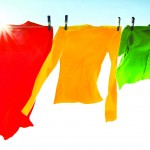By Patrick Keegan and Amy Wheeless
We have two kids, which means we do a lot of laundry. It never ends! What are some ways we can reduce our energy use in the laundry room?
The average American family washes about 300 loads of laundry per year — all that laundry uses a lot of energy! However, there are some easy ways to reduce your energy use in the laundry room.
• Consider purchasing more efficient appliances: One of the biggest changes is to purchase a new ENERGY STAR-certified washer and dryer.
Washers with this certification use about 40 percent less water and 25 percent less energy than standard washers. ENERGY STAR washers can be top-loading or front-loading machines; however, front-loading machines are generally more water and energy efficient, helping offset any additional upfront costs.
ENERGY STAR dryers use 20 percent less energy than standard dryers. Visit ENERGYSTAR.gov for more information and estimated water and energy use of all of its certified products.
• Get out of hot water: The easiest source of energy efficiency in the laundry room is to stop using hot water. Almost 90 percent of the energy consumed by your washing machine is used to heat water — but most loads of laundry can be just as easily cleaned with cold water. Using cooler water is also easier on your clothes. If you need to use hot or warm water on a particularly dirty load of laundry, a well-insulated water heater will help decrease the costs of using warmer water.
Do fewer loads! When possible, wash a full load of clothes. However, when you must do a smaller load of laundry, remember to adjust the water level settings on your machine.
• Help out your dryer: One of the best ways to reduce the amount of drying time is to get as much water out of the clothes as possible in the washing machine — use a higher spin setting to wring the extra water out of your laundry. When you are ready to dry, remember not to overfill the dryer so there is enough room for drying air to reach the clothes.
Use your dryer’s features: If your dryer has a moisture sensor, use it rather than guessing how long each load of laundry will need to dry. A dryer’s cool-down cycle uses the residual heat to finish drying your clothes, without using as much energy.
Dry like with like: Heavy fabrics, like towels and blankets, should be dried separately from lighter fabrics, like T-shirts. When using a dryer’s moisture sensor, the dryer will keep running until the wettest (and probably heaviest) item is dry. Rather than one towel extending the drying time for each of your loads of laundry, dry the towels together.
• Live lint free: Clean the lint trap on your dryer regularly to help air circulation. Periodically use a vacuum nozzle to clean the area under or behind the lint filter, where lint can also get caught. If you use dryer sheets, scrub the filter clean about once a month—dryer sheets can leave a film on the filter that reduces air flow.
• Remember safety: Your laundry room extends from the back of the dryer, down the dryer duct and all the way to the end of your dryer vent. Inspect your outside dryer vent regularly to make sure it is not blocked, and periodically work with a professional to clean your dryer ducts. Making sure the duct and vent are clear not only helps your dryer work more efficiently, but can also prevent a fire — more than 15,000 fires per year are sparked by clogged dryer ducts and vents. If possible, move the dryer closer to an exterior wall to shorten the length of the dryer duct and make sure the duct is as straight as possible — this helps reduce the opportunities for clogging and increases efficiency.
• Use your solar/wind-powered dryer: Going “old-fashioned” and air drying your clothes will definitely reduce your energy use! (If you live in a subdivision, check your covenants: clothes lines might be restricted.) To avoid the “crunchy” feeling that line-dried clothes can sometimes have, try tumble drying clothes until damp, then line dry them until fully dry.
There are many ways you can wash the energy waste out of your laundry routine. Try a few of these simple tips, and “load up” on the savings!
Patrick Keegan writes on consumer and cooperative affairs for the National Rural Electric Cooperative Association, service arm of the nation’s 900-plus consumer-owned, not-for-profit electric cooperatives based in Arlington, Virginia. Amy Wheeless writes for Collaborative Efficiency. For more information, visit:www.collaborativeefficiency.com/energytips or email Pat Keegan at energytips@collaborativeefficiency.com.




